Finding the perfect office chair can be a game-changer in the fast-paced world of modern work. Whether you're running a home office, a corporate workspace, or simply upgrading your office furniture, the right chair can significantly impact your comfort, productivity, and overall well-being. However, it's important to note that office chairs vary in quality and features.
With so many options available today, navigating the vast landscape of office chairs can be quite a challenge. That's where we come in! In this comprehensive guide, we'll share different types of office chairs and uncover the pros and cons of each style to help you find the right office chair.
11 Types Of Office Chairs
Ball Chairs
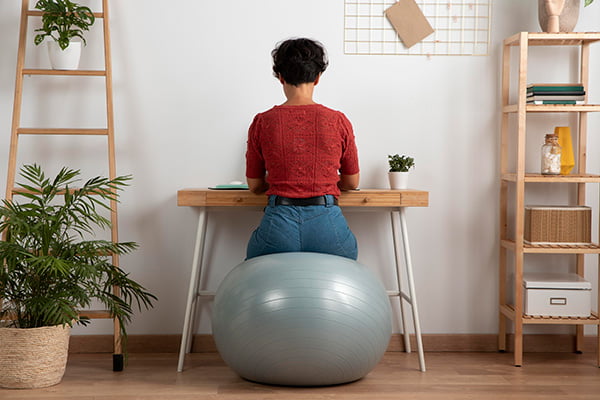
Image Source: Freepik
A ball office chair, also known as a stability or yoga ball chair, is a unique type of seating that replaces the traditional chair with an exercise ball (often made of rubber or PVC) as the seat. It's designed to promote active sitting and engage core muscles while you work.
Pros
Core Strength and Posture: One of the main advantages of a ball office chair is its potential to engage your core muscles while sitting. Balancing on the ball encourages you to maintain proper posture and engage your abdominal and back muscles, which can help improve core strength and reduce the risk of developing poor posture-related issues.
Active Sitting: Unlike traditional chairs, ball chairs allow for dynamic and active sitting. You can gently bounce or shift your weight, which may help prevent stiffness and promote blood circulation, potentially reducing the risk of back pain associated with prolonged sitting.
Versatility: Stability balls are not limited to office use. You can use them for various exercises and stretches during breaks, making them a versatile addition to your workspace.
Affordability: Ball office chairs are often more affordable than high-end ergonomic chairs, making them an attractive option for those on a budget.
Cons
Lack of Lumbar Support: Traditional office chairs often provide adjustable lumbar support, which can be crucial for maintaining good posture and preventing back strain. Ball chairs lack this built-in lumbar support, which could be a drawback for people with back issues.
Stability and Safety: Maintaining a balance on a ball can prove to be quite demanding, particularly when done over prolonged durations. The risk of falling or losing balance could lead to accidents or injuries, particularly in a busy office environment.
Limited Adjustment: Unlike ergonomic chairs that offer a range of adjustable features like seat height and armrests, stability ball chairs offer limited adjustment options. This can pose a challenge in achieving the optimal ergonomic configuration for individuals of diverse body types.
Discomfort: Some users may find sitting on a stability ball uncomfortable, especially during extended periods. The lack of cushioning and firm surface can lead to discomfort in the buttocks and thighs.
Durability: Stability balls may wear out or puncture over time, requiring replacement. The need for maintenance and replacement can add to the long-term cost.
Task Chairs
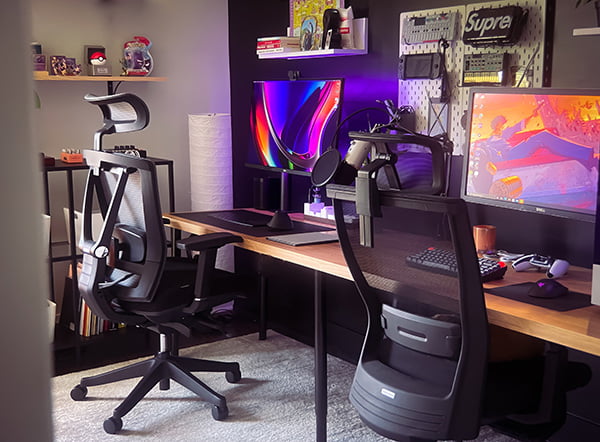
Image Source: Unsplash
A task chair will give you the arm and back support needed to get through the long working day. They are usually more ergonomic and allow more adjustments than swivel chairs, making them a better option for someone who suffers from back pain. Due to these factors, they are frequently employed as conference chairs.
Pros
Ergonomic Support: The task chair is designed with ergonomics in mind. They provide a range of customizable options, including seat height, seat depth, backrest height, lumbar support, armrests, and tilt mechanisms. These adjustments allow users to tailor the chair to their specific body shape and preferences, promoting good posture and reducing the risk of discomfort or strain.
Versatility: The task chair is highly versatile and can accommodate various tasks and work environments. Whether you need a chair for typing at a computer, writing, or other desk-related activities, a task chair can adapt to your needs.
Comfort: With their ergonomic design, task chairs are generally comfortable for extended periods of sitting. They properly support your back, shoulders, and arms, reducing fatigue risk.
Cons
Complex Adjustments: Some users may find the wide range of adjustment options overwhelming or confusing. It can take time to fine-tune the chair to your liking, and not everyone may utilize all the available adjustments effectively.
Space Requirements: Task chairs with a full range of adjustability may require more space than simpler office chairs, so they may not be suitable for smaller work areas.
Swivel Office Chairs
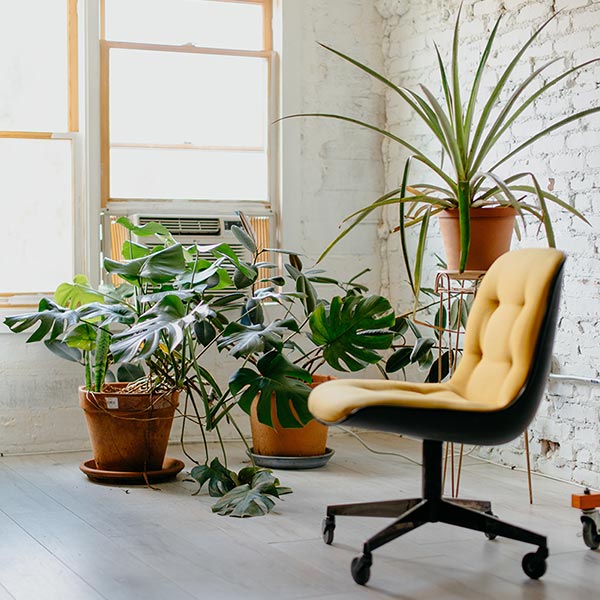
Image Source: Pexels
Swivel office chairs allow you to swivel, spin, and revolve 360 degrees. They usually have a fixed design, but some come with limited adjustable parts. If you prefer a certain height or adjustable armrests, be sure to see if your office chair has these features.
Pros
Ease of Movement: The primary advantage of a swivel chair is its ability to rotate, making it effortless to move around and access different areas of your workspace. This mobility can enhance productivity by reducing the need to stand up and reposition the chair constantly.
Accessibility: Swivel chairs are ideal for tasks that require reaching various parts of your desk or workspace, such as accessing files, supplies, or multiple computer monitors. This accessibility can be particularly beneficial in busy office settings.
Space Efficiency: Swivel chairs typically have a compact design and do not require much space to rotate, making them suitable for smaller work areas or cubicles where maneuverability is essential.
Versatility: Swivel chairs come in diverse styles, ranging from simple task chairs to executive-grade models. This variety allows you to choose a chair that suits your needs, whether you require a simple and functional chair or a more luxurious option.
Reduced Strain: The ability to swivel in your chair can help reduce strain on your neck, shoulders, and back, as you can easily position yourself to face differ
Cons
Lack of Lumbar Support: Some swivel chairs, especially simpler models, may lack adequate lumbar support, leading to discomfort and potential back issues over time. Choosing a swivel chair with proper ergonomic features is important if you require lumbar support.
Limited Adjustability: While many swivel chairs offer basic height adjustment, they may lack some advanced ergonomic features in task chairs, such as adjustable armrests or seat depth.
Noise: Swivel chairs with plastic or metal casters can create noise when moved across hard surfaces, potentially disrupting a quiet office environment.
Gaming Chair
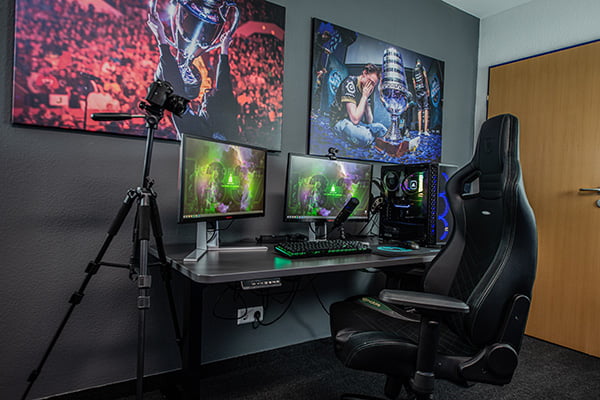
Image Source: Unsplash
Gaming office chairs, alternatively referred to as gaming chairs or racing-style chairs, are engineered to deliver comfort and support during extended gaming sessions. Their popularity extends not only to gamers but also to individuals who find themselves working at a desk for prolonged periods. These chairs are often characterized by their distinctive, high-back racing-style design and ergonomic features.
Pros
Ergonomic Design: Gaming chairs are designed with ergonomic principles as a top priority. These chairs commonly provide adjustable features like seat height, backrest tilt, and armrests, granting users the flexibility to tailor their seating position for the utmost comfort and support.
Comfort: Gaming chairs often feature thick cushioning and lumbar support pillows, providing a comfortable sitting experience during long periods of use. The high backrest design can also offer neck and head support.
Durability: High-quality gaming chairs are constructed with sturdy materials and can withstand the demands of daily use. They are often built to last and may come with warranties.
Versatility: While designed for gaming, these chairs can be used for various tasks, including office work, studying, and leisure activities like watching TV or reading.
Cons
Limited Adjustability: While gaming chairs offer various adjustments, some users may find that they lack certain ergonomic features commonly found in dedicated office chairs, such as seat depth adjustment or synchronized tilt mechanisms.
Size and Fit: The design of gaming chairs may only be suitable for some body types, and some users may find them less comfortable or supportive if they match the chair's intended size range.
Bulkiness: Gaming chairs can have a bulkier and more prominent design, which may be better for smaller workspaces or offices with limited space.
Ergonomic Chairs
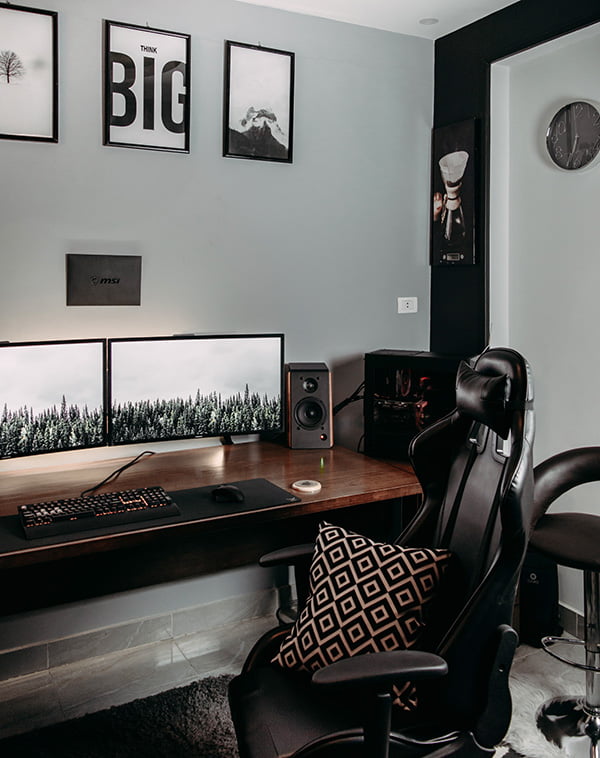
Image Source: Unsplash
Ergonomic office chairs are designed to offer the highest level of comfort and support during extended periods of sitting, making them a highly recommended choice among office chairs. This type of chair is often big and has a higher back. These big and tall chairs typically feature adjustable lumbar support, headrests, armrests, and customizable seat height and tilt. These chairs encourage proper posture and mitigate the likelihood of experiencing back and neck strain.
Pros
Superior Comfort: Ergonomic chairs are specifically designed to offer exceptional comfort during extended periods of sitting. They often feature high-density foam padding, contoured seats, and backrests that conform to the spine's natural curve.
Customizable Ergonomics: Ergonomic chairs are equipped with a diverse set of adjustable features, which commonly encompass customizable seat height, seat depth, backrest height, lumbar support, armrests, and tilt mechanisms. These adaptable options empower users to personalize the chair to suit their unique body shape and work preferences.
Posture Support: One of the key advantages of ergonomic chairs lies in their capacity to encourage correct posture. By aiding in the proper spine alignment, they effectively minimize the likelihood of musculoskeletal problems, including back pain, neck discomfort, and shoulder strain.
Long-Term Health Benefits: Ergonomic chairs are designed to mitigate the negative effects of prolonged sitting, such as poor circulation and back problems. Investing in an ergonomic chair can contribute to long-term health and well-being.
Aesthetics: Many ergonomic chairs come in stylish designs and various upholstery options, allowing them to fit seamlessly into different office environments.
Cons
Cost: The quality ergonomic chair can be relatively expensive compared to a standard office chair. However, they are often seen as a worthwhile investment in comfort and health.
Complex Adjustments: Some users might perceive the extensive array of adjustment choices as overwhelming or challenging to calibrate accurately. Achieving the perfect chair configuration can indeed be a time-consuming process.
Space Requirements: Ergonomic chairs with full adjustability may require more space than simpler office chairs. They may not be suitable for smaller work areas.
Executive Chairs
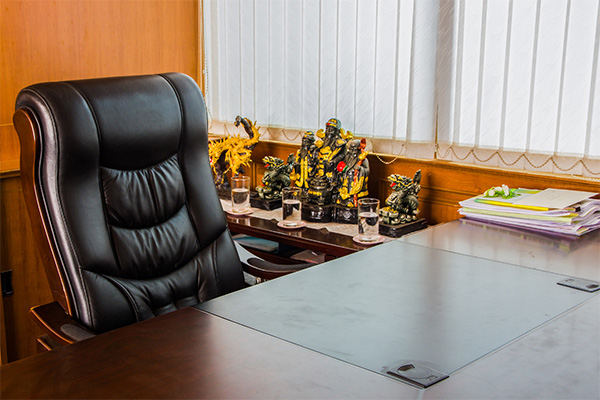
An executive chair is an office chair designed for high-ranking professionals and individuals in leadership roles. These chairs are often characterized by their luxurious and commanding appearance, featuring high backs, premium materials, and additional comfort and style features. They typically feature tall backrests, ample cushioning, and upholstery made from leather. These leather chairs are commonly used in executive offices and boardrooms, adding an air of sophistication to the workspace.
Pros
Comfort: The executive chair is typically designed with comfort in mind. They often come with ample padding, cushioned armrests, and ergonomic features like built-in lumbar support. These elements provide a high comfort level, making long work hours more bearable.
Durability: High-end executive chairs are built to last. They are constructed from sturdy materials and are designed to withstand daily use over extended periods, making them a durable investment.
Cons
Cost: One of the significant drawbacks of executive chairs is their cost. Executive chairs of high quality are frequently more costly when compared to standard office chairs. They are considered luxury items, and the premium materials and craftsmanship contribute to their price.
Bulkiness: Executive chairs have larger dimensions, especially their high backs, and broader seats. This can be a disadvantage in smaller office spaces, where they may not fit comfortably.
Maintenance: Leather office chairs exude luxury but demand consistent maintenance to prevent signs of wear and tear. Over time, these materials may show signs of aging or damage, necessitating care and cleaning.
Mesh Office Chairs
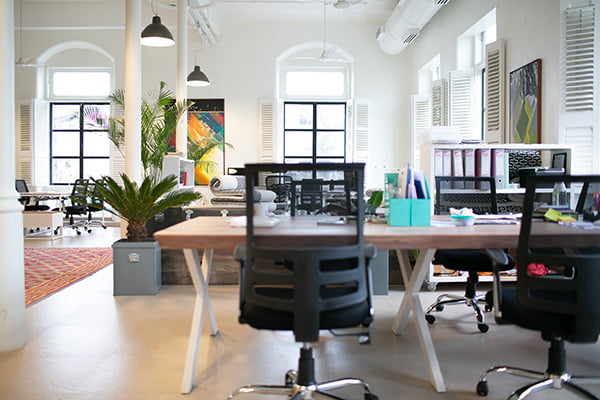
Image Source: Unsplash
Mesh office chairs have gained popularity because of their breathability and contemporary appearance. These chairs have gained popularity in modern office environments due to their comfort, support, and breathability.
Pros
Breathability: The main benefit of mesh office chairs lies in their exceptional breathability. The mesh backrest allows air to circulate freely, preventing heat and moisture buildup. This feature can be particularly beneficial in warm or humid environments, reducing discomfort caused by sweating.
Comfort: The flexible nature of the mesh material provides a comfortable seating experience. Mesh material conforms to the user's body shape, delivering gentle support while avoiding the creation of pressure points. The cushioned seat in some mesh chairs enhances overall comfort.
Lightweight and Aesthetically Pleasing: Mesh chairs are often lighter in weight than traditional padded chairs, making them easier to move and adjust. Additionally, their modern and minimalistic design can complement various office decor.
Easy Maintenance: Mesh upholstery is relatively easy to clean and maintain. It's resistant to spills and stains, and the open design makes it less susceptible to dust and allergen buildup.
Cons
Durability: While mesh chairs can be durable, the mesh material may not be as robust as traditional upholstered chairs. Over time, the mesh can stretch or wear out, potentially reducing the chair's lifespan.
Lack of Padding: Some users may discover that mesh chairs lack the plush cushioning often found in traditional chairs, potentially resulting in discomfort during prolonged sitting sessions. Nevertheless, it's important to note that this can vary depending on the particular chair's design and features.
Price: Higher-quality ergonomic mesh chairs can be relatively expensive. While they offer several benefits, their cost may be a consideration for budget-conscious buyers.
Drafting Chairs/Stools
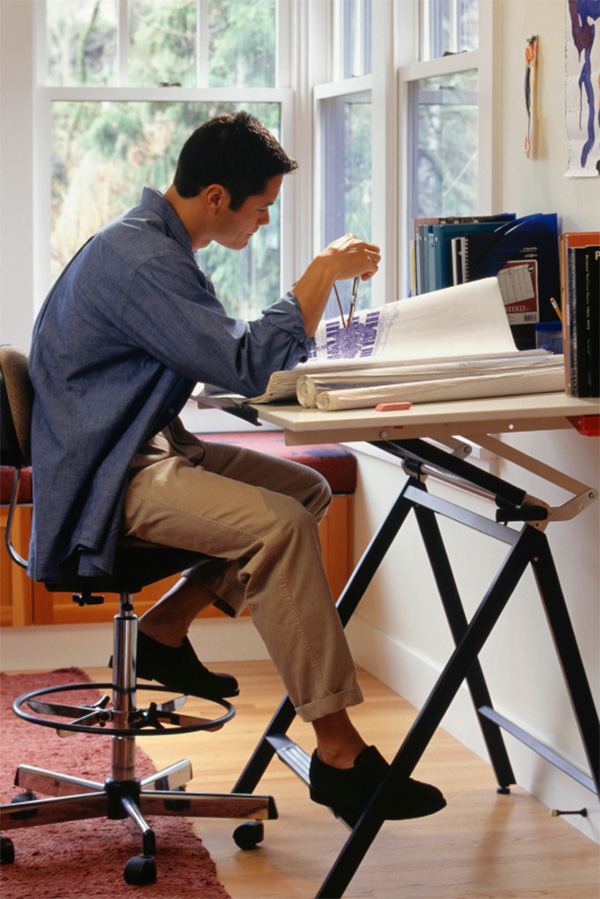
Drafting chairs, also known as drafting stools or chairs, are specialized office chairs designed for use on elevated work surfaces like drafting tables, standing desks, or counters. They are characterized by their tall seat height, footrests, and, sometimes, a lack of armrests.
Pros
Height Compatibility: Drafting chairs are designed to provide the right seat height for working on elevated surfaces. This is especially useful for artists, architects, engineers, and anyone who regularly uses drafting tables or standing workstations.
Footrests: Many drafting chairs have built-in footrests or footings, providing support and comfort to the legs and feet. This can alleviate fatigue during prolonged periods of sitting or standing.
Swivel Functionality: Like standard office chairs, many drafting chairs feature a swivel base, allowing users to easily rotate and access different parts of their workspace without leaving the chair.
Mobility: Drafting chairs with casters (wheels) are highly mobile, making it easy to move around your workspace, whether working at a drafting table, standing desk, or counter.
Cons
Limited Versatility: Drafting chairs are specialized for use on elevated surfaces. While they excel in these settings, they may not be suitable for standard-height desks or tables, limiting their versatility in some office environments.
Taller Height Can Be Inconvenient: While the taller seat height is essential for specific tasks, it can be inconvenient to switch between sitting and standing frequently or work at both elevated and standard-height surfaces.
Comfort: The level of comfort provided by drafting chairs can fluctuate significantly based on the chair's design and overall quality. Some may have minimal cushioning and ergonomics, leading to discomfort during prolonged use.
Kneeling Chairs
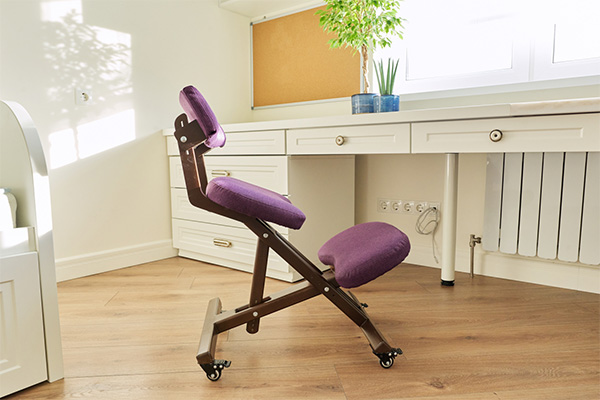
Kneeling office chairs, also known as kneeling stools or ergonomic kneeling chairs, are unconventional seating options designed to encourage a more open and dynamic sitting posture. They consist of a sloping seat and knee pads, which promote a kneeling position while working.
Pros
Improved Posture: Kneeling chairs promote an open hip angle and a more upright, aligned posture. This can assist in alleviating strain on the lower back and promoting a natural, ergonomic sitting posture.
Reduced Lower Back Pain: Many users find that kneeling chairs alleviate lower back pain and discomfort associated with prolonged sitting. The open hip angle can relieve pressure on the lumbar spine.
Active Sitting: Kneeling chairs engage the core muscles and encourage micro-movements while sitting. This encourages improved circulation and aids in mitigating the adverse health effects associated with extended periods of sitting.
Compact Design: Kneeling chairs are often compact and lightweight, making them suitable for small workspaces or offices with limited room for traditional office chairs.
Portability: Kneeling chairs are easy to move around and can be used in various locations, such as at a desk, worktable, or as an occasional chair for short tasks.
Cons
Initial Discomfort: Users transitioning to a kneeling chair may experience initial discomfort or muscle fatigue as their bodies adapt to the new sitting position. Developing the essential core strength to sit comfortably for extended durations may require some time and effort.
Limited Versatility: Kneeling chairs are specifically designed for tasks that don't require a desk or table for support. They may not be suitable for activities like typing on a keyboard, as users may need a separate surface for their arms and equipment.
Knee Pressure: Extended use of a kneeling chair may put pressure on the knees, leading to discomfort or knee strain in some individuals. Using a chair pad or cushion can help alleviate this issue.
Lack of Back Support: Kneeling chairs do not provide traditional backrests, which may disadvantage those who prefer or require lumbar support.
Reclining Chairs
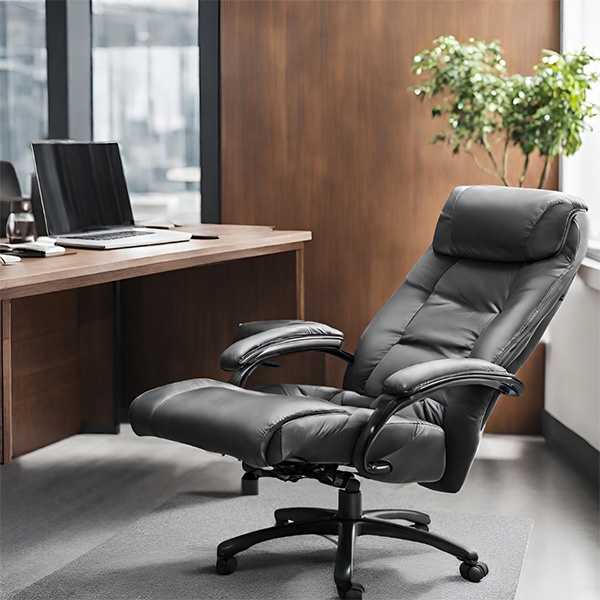
Reclining office chairs are specific types of office chairs designed to provide comfort and relaxation, allowing users to recline the backrest and often extend the footrest. These chairs offer a degree of adjustability beyond traditional office chairs.
Pros
Comfort: Reclining office chairs are built with user comfort in mind. These chairs provide a range of seating positions, enabling you to discover the most comfortable angle for tasks like working, reading, or resting. This enhanced comfort can help minimize the likelihood of discomfort and fatigue during extended work hours.
Back Support: Many reclining chairs have built-in lumbar support and ergonomic features to promote healthy posture, even in reclined positions. This support can assist in alleviating back pain and strain.
Versatility: Reclining chairs are versatile and suitable for a range of tasks. You can use them for focused work, relaxation, or short breaks. Certain models even incorporate built-in massage or heating features to enhance comfort further.
Improved Circulation: Reclining chairs can elevate your legs, promoting better blood circulation. This can be particularly beneficial if you encounter swelling or discomfort in your lower limbs.
Cons
Space Requirements: Reclining chairs often have larger dimensions, especially when fully reclined. This can be an issue in smaller workspaces where space is limited.
Cost: High-quality reclining office chairs with advanced features can come at a relatively higher price point compared to standard office chairs. This cost may be a factor to consider for budget-conscious users.
Complex Adjustments: Some users may find the wide range of adjustment options and recline angles overwhelming or challenging to configure correctly.
Folding Chairs
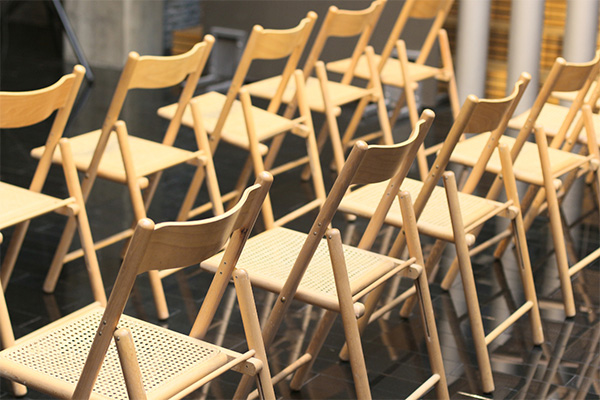
Folding office chairs are portable and space-saving seating solutions designed for use in office environments where flexibility and convenience are required. These chairs can be conveniently folded and stowed away when not in use, rendering them ideal for meetings, conferences, training sessions, or as temporary seating solutions.
Pros
Portability: Folding office chairs are exceptionally portable thanks to their lightweight build and collapsible design. This portability enables easy transportation, making them well-suited for off-site meetings or events.
Space-Saving: One of the key benefits of folding office chairs is their space-saving capability. When not in use, they can be folded and stacked, allowing for efficient storage in small office spaces or when setting up temporary workstations.
Quick Setup: Folding office chairs can be set up and arranged quickly, making them a convenient seating solution for meetings or events that require rapid preparation.
Affordability: Folding office chairs are generally budget-friendly, making them accessible to various budgets and organizations.
Cons
Style Limitations: Folding office chairs tend to have a useful design, which may not be suitable for formal or upscale office settings.
Lack of Customization: Folding office chairs generally have limited adjustability, such as seat height or backrest angle, which may only accommodate the ergonomic needs of some users.
